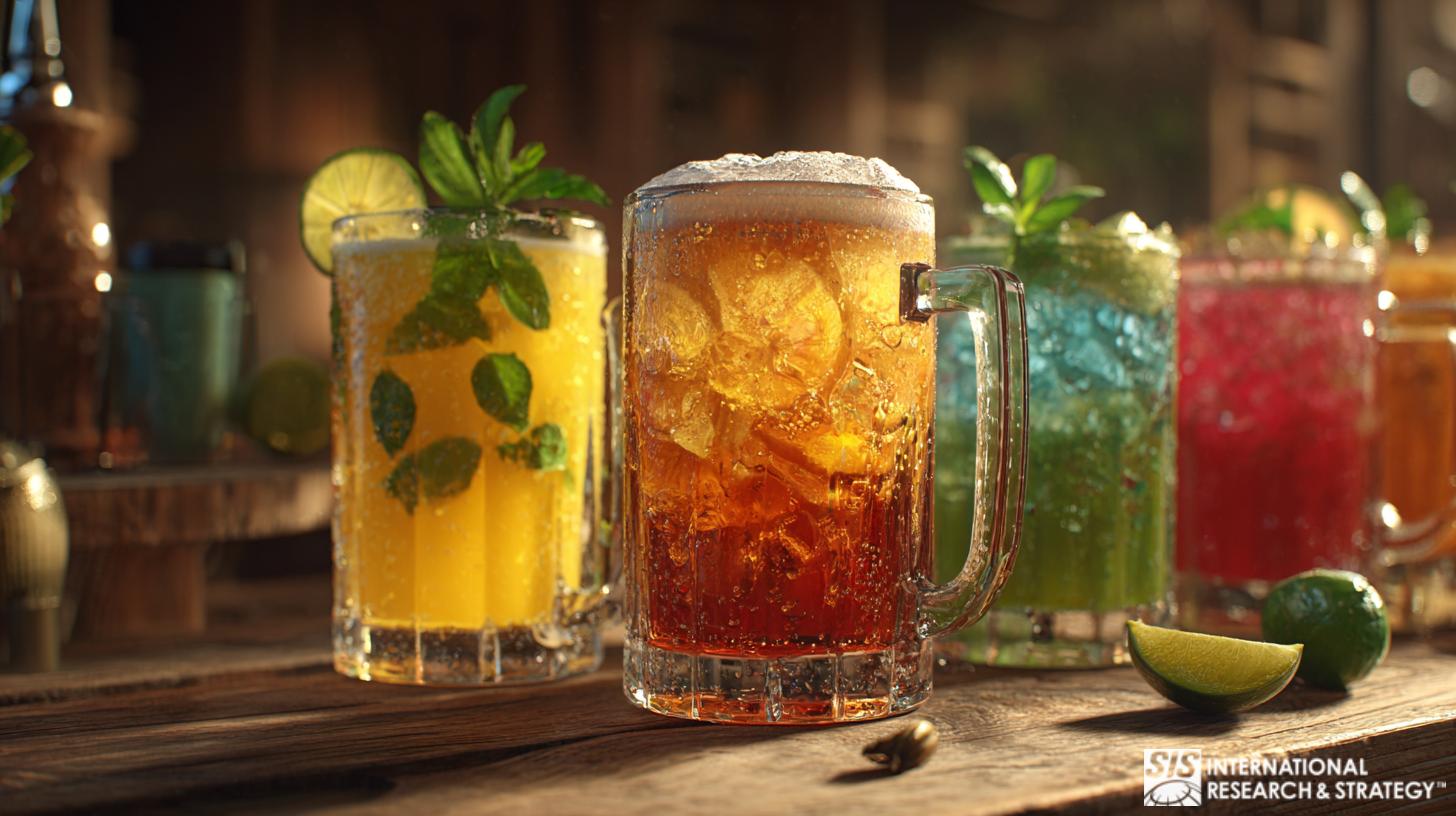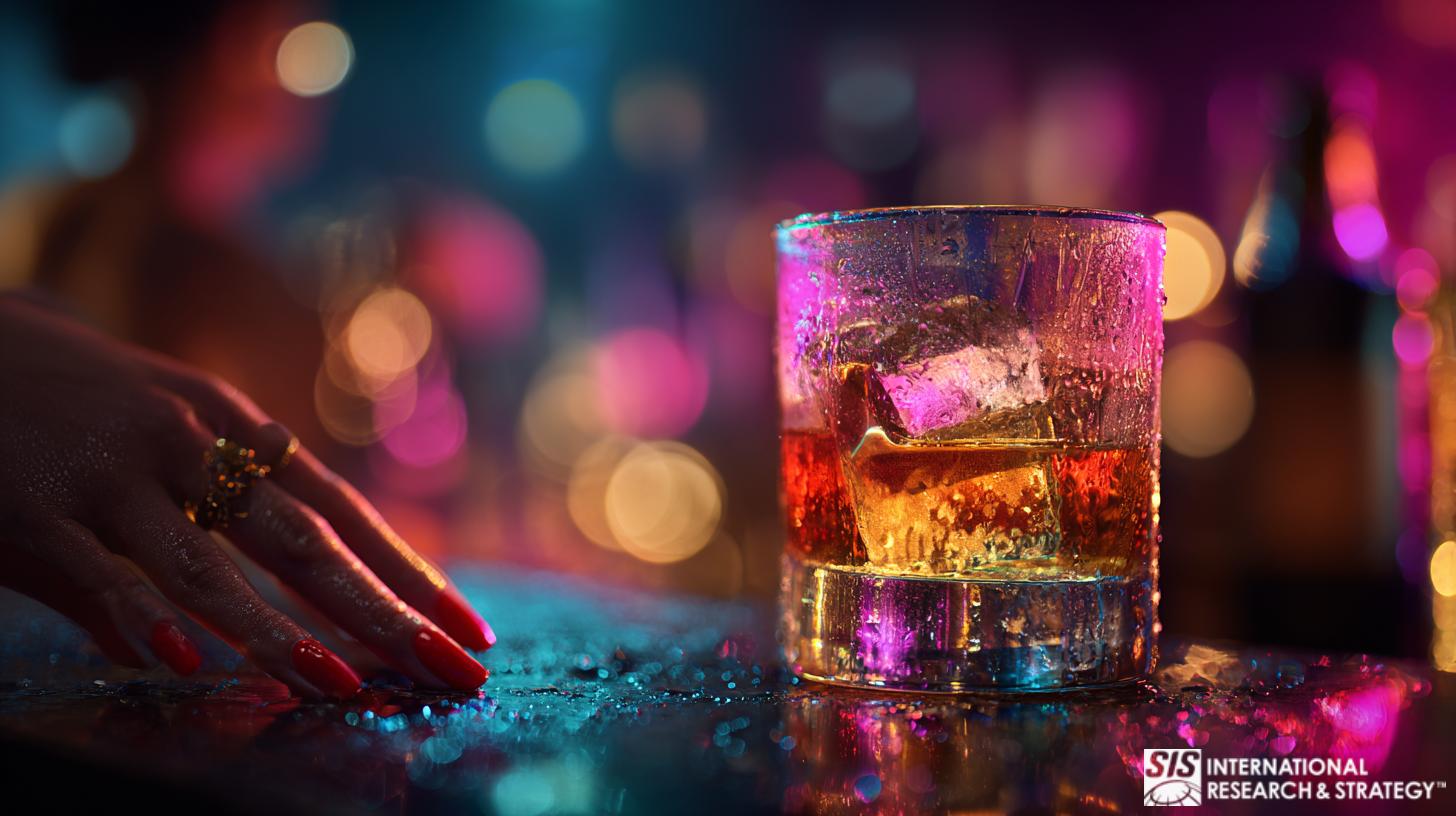酒味测试

酒精味觉测试在饮料行业中发挥着至关重要的作用。它可确保风味特征的一致性、识别缺陷或异味,并指导开发符合消费者偏好的新产品。
品牌如何确保其酒精饮料脱颖而出并始终满足鉴赏家和休闲饮酒者的高期望?制作完美酒精饮料的工艺和科学是一门艺术——酒精品尝测试为市场成功奠定了基础,确保每一口都为消费者提供发现和愉悦的旅程。
电视able of Contents
什么是酒精味觉测试?
Alcohol taste testing is an in-depth analysis of the complex flavor profiles, aromas, and textures that define alcoholic beverages. It assesses the quality, character, and appeal of drinks, ranging from wines and spirits to beers and cocktails.
This taste testing evaluates the sensory characteristics of alcoholic beverages, including wine, beer, and spirits. It involves assessing appearance, aroma, taste, and mouthfeel to determine the beverage’s quality and characteristics.
During alcohol taste testing, trained professionals, known as “sensory panelists,” use their senses to identify and describe various beverage attributes, such as fruitiness, acidity, sweetness, and bitterness. These evaluations help producers understand consumer perceptions of their products and make informed decisions about product development and quality control.
企业为何需要进行酒精口味测试?

Alcohol taste testing is essential for ensuring product quality and consistency. It allows producers to identify variations and make the necessary adjustments to ensure that every product reaching consumers maintains the brand’s quality standards. This consistency is critical to building and maintaining consumer trust and loyalty, as customers expect the same experience with every purchase.
此外,酒精品尝测试有助于创新和差异化,因为生产商可以尝试新的口味、混合和酿造或蒸馏技术,以创造吸引市场兴趣的创新产品。对于希望引领而不是追随市场趋势的品牌来说,这种探索和改进的过程至关重要。
此外,酒精口味测试还能提供宝贵的消费者偏好见解,让品牌能够定制产品以满足目标受众不断变化的口味。此外,它还为企业带来了许多其他好处,包括:
- 批次间的一致性: 酒精味道测试使品牌能够密切监测变化并调整其方法,以确保消费者获得一致的产品体验。
- 市场差异化: 通过酒精口味测试,品牌可以探索创新的口味组合、生产技术和独特的成分特征,使其产品脱颖而出。
- 符合消费者偏好: 酒精味道测试可以深入了解目标市场的口味和偏好,使品牌能够定制产品以满足这些期望。
- 增强品牌叙事: 通过酒精口味测试发现的细微差别和品质可以丰富品牌的叙述,使其能够讲述有关其传统、工艺和对品质的承诺的更引人入胜的故事。
谁使用酒精味觉测试
这 生产烈酒、啤酒和其他酒精饮料的工匠 是酒精品尝测试的主要用户。对于这些专业人士来说,这一过程对于确保其产品的质量和一致性至关重要。 酿酒商和啤酒酿造商 还通过味觉测试来改进配方,调整发酵和蒸馏过程,并确保每批产品都符合严格的风味、香气和口感标准。
侍酒师和调酒师 rely on alcohol taste testing to deepen their understanding of different beverages and how they can be combined or presented to enhance the drinking experience. These professionals use their refined palates to curate selections for restaurants, bars, and events, ensuring each offering is high-quality and suits the intended audience or theme.
在规模较大的饮料公司中, 质量控制分析师 conduct alcohol taste testing during production to ensure every product meets the brand’s quality standards. These analysts look for any deviations in taste, aroma, or appearance that could indicate issues with the production process, helping to prevent subpar products from reaching the market.
Global Alcohol Industry Market Data & Consumer Taste Insights
| 细分市场 | Current Value / Data | Projected Growth | Key Consumer Insights |
|---|---|---|---|
| GLOBAL MARKET SIZE & GROWTH | |||
| Total Alcoholic Beverages Market | $2,413.8B (2024) | $3,866.1B by 2032 CAGR: 6.04% |
Driven by premiumization trends and rising disposable incomes globally, particularly in emerging economies where middle-class growth accelerates demand. |
| Craft Spirits Market | $21.32B (2024) | $52.85B by 2033 CAGR: 10.61% |
Exceptional growth fueled by consumer demand for authenticity, artisanal production, and unique flavor profiles. Millennials and Gen Z driving innovation. |
| Distilled Spirits Segment | $82.01B (2024) | $226.82B by 2032 CAGR: 13.56% |
Fastest-growing segment with vodka dominating US consumption (77M 9-liter bottles annually), followed by rum, whiskey, and tequila. |
| REGIONAL MARKET LEADERSHIP | |||
| North America Market | $895.8B (38.4% share) | Leader in craft spirits US CAGR: 29.4% |
US consumers show strong preference for premium spirits and craft beers. Per capita alcohol consumption: 2.35 gallons annually, with diverse product preferences. |
| Europe Market | 45% global share | 10,000+ craft breweries operating | Strong tradition of alcohol consumption with 26% of global volume. Growing premiumization and craft beverage preference across all categories. |
| India Market (Emerging) | Rapid expansion phase | CAGR: 35.6% (craft spirits) | Fastest-growing market driven by rising disposable incomes, improving quality of life, and willingness to spend on premium beverages with local flavors. |
| CONSUMER TASTE PREFERENCES & SEGMENTS | |||
| Wine Consumer Preferences | Merlot: 23% Chardonnay: 19% Cabernet: 19% |
Premium wine tourism expanding | Wine drinkers seek authentic experiences. Pinot noir (17%), pinot grigio (16%), and rosé (15%) follow. Sustainability and organic production increasingly important. |
| Beer Consumer Segments | Light beer: 1.2B bottles Craft beer: 310M bottles |
Craft beer continuing growth | American consumers drank 1.2 billion cases in 2018. Taste testing reveals consumers prefer balanced mouthfeel, moderate alcohol warmth, and natural drinkability. |
| “Mild-Drink Lovers” Segment | 44% of consumers | Growing demographic | Predominantly women aged 18-29 with higher orosensory responsiveness. Prefer drinks with intense sweet taste and mixers that moderate ethanol perception. |
| Alcohol Consumption Rate | 62% of US adults (18+) | 20% reducing for health | One in five consumers has reduced alcohol consumption for healthier choices. Non-alcoholic alternatives projected to grow 70% as consumer priorities shift. |
| SENSORY ANALYSIS & TASTE TESTING INSIGHTS | |||
| Sensory Attributes Evaluated | 19-21 attributes standard | AI-driven analysis emerging | Professional panels assess appearance, aroma, taste, mouthfeel, aftertaste. Multiple evaluation periods (in-mouth, post-swallow, aftertaste) provide comprehensive profiles. |
| Consumer Taste Testing Methods | Paired preference tests Triangle tests Ranking tests |
30+ panelists minimum | Blind tasting protocols eliminate bias. Statistical analysis ensures reliable results. Consumers increasingly participate via smartphone-based home testing. |
| Key Flavor Drivers | Sweet, balanced, refreshing | Customization increasing | Low-frequency drinkers prioritize overall drinking comfort. High-frequency consumers focus on aroma subtleties. Alcohol warmth and persistence are mid-tier factors. |
| INNOVATION & PREMIUMIZATION TRENDS | |||
| Craft Distillery Growth | 21,745 US craft businesses | $32B annual sales | Craft beverages account for 8% of total US alcohol sales. Small-batch production, unique flavor infusions, and sustainable practices differentiate products. |
| Premium Product Preference | Leading market trend | All segments affected | Consumers willing to pay premium for high-quality, authentic experiences. Taste testing guides product development toward distinctive flavor profiles and artisanal character. |
| Cocktail Culture Impact | 60% of bartenders use local ingredients | Mixology driving innovation | Rise of upscale bars and restaurants accelerates demand for base spirits (gin, rum, whiskey). Consumers seek unique, curated experiences over mass-produced options. |
| ECONOMIC CONTRIBUTION & MARKET DYNAMICS | |||
| Federal Tax Revenue (US) | $11B (FY 2023) | 0.25% of total tax revenue | Distilled spirits contribute 60% of alcohol tax revenue, beer 30%, wine 10%. Industry supports extensive employment across production, distribution, and retail. |
| 分销渠道 | On-trade: 57.4% (2023) Off-trade: 42.6% |
E-commerce expanding rapidly | Restaurants, bars, and pubs lead sales but off-trade (supermarkets, wine shops) growing at 29.8% CAGR. Digital platforms enhancing accessibility. |
| 资料来源: Fortune Business Insights – Alcoholic Beverages Market | Straits Research – Craft Spirits Market | Grand View Research – Craft Spirits Analysis | Data Bridge Market Research – Global Spirits | Alcohol.org – Industry Statistics | Market.us – Alcoholic Beverages Report | PubMed – Consumer Preference Research | |||
何时进行酒精味觉测试
Identifying the optimal moments to conduct alcohol taste testing is crucial for maximizing its benefits across product development, marketing, and quality assurance. This strategic timing ensures that the insights gained from the testing process are both relevant and actionable – and here’s a breakdown of critical instances when alcohol taste testing is particularly vital:
- 产品发布前: 在推出新产品之前进行酒精口味测试至关重要。通过初步评估,品牌可以根据专家和消费者的反馈改进产品,确保产品符合市场预期,并有很大的成功几率。
- 在产品开发过程中: 酒精味觉测试在产品开发阶段起着至关重要的作用。它使品牌能够尝试不同的配方、混合物和陈化过程,以评估它们对最终产品风味特征和整体感官体验的影响。
- 生产或原料改变后: 每当生产过程或原料来源发生变化时,酒精味觉测试就变得必不可少。这些变化会显著影响最终产品的口味和质量。味觉测试可确保尽管发生了这些变化,产品仍符合品牌的标准和消费者的期望。
- 回应消费者的反馈: 如果品牌收到大量消费者反馈或注意到消费者偏好发生变化,进行有针对性的酒精口味测试可能会有所帮助。这让品牌能够探索新的口味或对其产品进行调整,以更好地迎合当前的口味,确保其产品保持相关性并吸引受众。
- 探索和适应市场趋势: 在探索新的市场趋势和适应消费者偏好的变化时,酒精口味测试至关重要。随着饮料行业的发展,保持领先趋势(例如人们对低酒精或无酒精饮料的兴趣日益浓厚)需要品牌不断测试和改进其产品以满足不断变化的消费者需求。
无论如何,企业经理必须问自己这些问题:
- 目的:品尝测试的目的是什么?是为了收集新产品的反馈、评估现有产品的质量,还是其他什么?
- 样品选择: 如何选择样品?它们会代表一系列的口味、风格或品牌吗?
- 品鉴环境:品尝测试在哪里进行?环境是否有利于准确品尝,没有干扰和强烈的气味?
- 品尝者精选:谁将参加品尝测试?他们是经过培训的专业人士、消费者,还是两者兼而有之?
- 评价标准: 评估样品的标准是什么?品酒师会寻找特定的风味、香气或特征吗?
- 反馈收集:如何收集和分析反馈?会以匿名方式进行吗?会记录下来以供将来参考吗?
酒精味觉测试中增长最大的领域是什么?
- 精酿烈酒:威士忌、杜松子酒和朗姆酒等手工酿制烈酒的受欢迎程度不断上升,导致该领域对品尝服务的需求增加。
- 葡萄酒: The industry continues to grow, with consumers eager to explore different varieties and regions. This drives the need for taste testing to evaluate quality and characteristics.
- 非酒精替代品:无酒精烈酒和葡萄酒等非酒精饮料市场正在增长,为通过味觉测试开发吸引人的口味创造了机会。
- 功能性饮料:功能性饮料(例如含有 CBD 或其他健康成分的饮料)越来越受欢迎。它们需要进行口味测试以确保消费者接受。
SIS International 酒精味觉测试的预期结果

与 SIS International 合作进行酒精味觉测试时,企业可以期待一系列重要的成果,这些成果可以增强其饮料的感官吸引力,并在竞争激烈的酒精市场中取得战略性成功。以下是全面的酒精味觉测试过程可以预期的关键结果:
提高产品质量:
One of the primary outcomes is a tangible improvement in the beverage’s overall quality. This encompasses taste, aroma, and mouthfeel refinement, ensuring that the product meets and exceeds industry and consumer expectations.
符合消费者口味:
通过味觉测试获得的见解可以精确匹配消费者的偏好。这确保产品符合当前趋势和消费者需求,从而提高市场接受度和消费者满意度。
战略市场定位:
酒精品尝测试的详细分析和反馈可为市场定位和产品开发方面的战略决策提供参考。这使品牌能够更有效地瞄准特定的消费群体并利用新兴市场机会。
明智的产品开发:
The data-driven insights from taste testing guide the product development process, ensuring that new products are well received by the target market and are more likely to succeed upon launch.
持续改进的反馈循环:
酒精口味测试建立了一个有价值的反馈循环,可以不断改进现有产品并指导未来产品的开发。这一迭代过程确保品牌能够适应不断变化的消费者偏好并保持竞争力。
Global Alcohol Market Growth Projections
Market value trends showing the expansion of total alcoholic beverages market alongside high-growth segments including craft spirits, distilled spirits, and premium wine categories through 2033.
Data demonstrates why taste testing and quality assurance are critical investments as markets expand and consumer expectations rise.
Key Growth Insights
- Total Market: Growing from $2.4T (2024) to $3.9T (2032) at 6.04% CAGR, driven by premiumization and emerging market demand
- Craft Spirits: Exceptional 10.61% CAGR reaching $52.9B by 2033, fueled by consumer demand for authenticity and unique flavors
- Distilled Spirits: Fastest-growing at 13.56% CAGR, expected to reach $226.8B by 2032 with vodka, whiskey, and tequila leading
- Quality Focus: As markets expand, taste testing becomes essential for maintaining consistency and meeting elevated consumer expectations
酒精味觉测试的优点和缺点
优点:
- 质量保证:酒精味道测试确保产品符合预期的口味和质量标准。
- 消费者满意度:味觉测试可以确保产品满足消费者的期望,从而提高消费者的满意度和忠诚度。
- 产品改进:口味测试的反馈可用于改进产品,从而获得更好的市场认可。
缺点:
- 成本:进行味觉测试可能很昂贵,特别是涉及许多样品或聘请专业品尝师时。
- 主观性:口味是一个主观现象,每个品尝者可能有不同的喜好,导致结果不一致。
- 耗时:味觉测试需要时间和资源来组织和进行,这对于日程安排紧张的企业来说可能是一个缺点。
Step-by-Step Process of Alcohol Taste Testing
本分步指南概述了典型品尝过程的关键阶段,并提供了专家如何评估和欣赏不同酒精饮料的见解。
- 样本选取: Taste a variety of alcoholic beverages, including wines, beers, and spirits. Select samples that represent a range of flavors, styles, and brands.
- 样品制备: Ensure the samples are served at the correct temperature and in appropriate glassware to enhance the tasting experience. This includes using clean, odor-free glasses and serving the samples at the recommended temperature.
- 视觉检查: Inspect each sample visually. Note the beverage’s color, clarity, and viscosity. These visual cues can provide insights into the product’s age and quality.
- 香气评估:旋转玻璃杯以释放香气,然后嗅一下饮料以识别各种气味。注意香气的强度和复杂性以及任何特定的味道,例如水果、花香或香料。
- 口味评价: Take a small sip of each sample and allow it to coat your palate. Note the flavors present, including initial impressions and how they evolve. Consider the balance of flavors and the intensity of each component.
- 口感分析:考虑饮料在口中的质感和口感。注意粘度、碳酸化程度(对于啤酒而言)以及酒精带来的顺滑感、涩味或温热感。
- 总体印象:考虑每种样品的平衡性、复杂性和回味长度,形成对每种样品的总体印象。评估口味的协调性以及饮料是否令人愉悦和难忘。
- 讨论与比较:与其他人(包括同行品酒师和专家)讨论您的发现,以获得不同的观点和见解。比较每个样品的笔记,以确定共同的主题和差异。
SIS 酒精味觉测试方法
SIS International 的酒类品尝测试方法以其严谨的方法、深厚的专业知识和战略洞察力脱颖而出,旨在为酒类品牌提供一条通往卓越的清晰道路。这种多方面的方法确保了饮料的感官优越性并与市场趋势和消费者偏好保持一致。
专家主导的评估:
Expert-led evaluations are central to the SIS approach, where seasoned tasters with extensive experience in the alcohol industry conduct comprehensive assessments. These experts utilize a refined palate and deep knowledge of sensory analysis to discern and describe each beverage’s intricate flavors, aromas, and textures. This level of expertise ensures a thorough, nuanced understanding of the product’s sensory profile.
结构化感官分析:
SIS employs a structured sensory analysis framework that encompasses a range of attributes specific to alcoholic beverages. This includes but is not limited to appearance, aroma, body, taste, and finish. By adopting standardized evaluation protocols and using sensory lexicons, SIS ensures that analyses are detailed and consistent across sessions and products.
消费者洞察的整合:
SIS 方法的与众不同之处在于将消费者洞察融入到酒精品尝测试过程中。我们认识到,饮料的最终成功取决于目标市场的接受度,因此我们将感官评估与市场研究相结合。这种双重方法使品牌能够了解其产品如何引起消费者的共鸣,并找出符合消费者口味和偏好的机会。
可行的建议:
Following the taste testing sessions, SIS provides brands with actionable recommendations based on the collected data. These recommendations are tailored to address each brand’s specific needs and objectives. The goal is to empower brands with the insights to make informed decisions that enhance their products’ appeal and market performance.
注重持续改进:
SIS 方法的特点是注重持续改进。酒类市场瞬息万变,消费者的偏好不断变化,趋势层出不穷。SIS 鼓励品牌进行持续的口味测试,以开发产品并保证质量。这种持续改进的承诺可确保品牌适应市场变化并保持竞争优势。
机会
酒精品尝测试为酒精行业的企业提供了多种机会,使他们能够改进产品,了解市场,并为增长和成功做好战略定位。以下是参与酒精品尝测试带来的一些关键机会:
- 产品创新和多样化: Alcohol taste testing encourages innovation by allowing businesses to experiment with new flavors, ingredients, and production techniques. This experimentation can lead to the development of unique products that meet emerging consumer trends, such as craft spirits, non-traditional blends, or low-alcohol beverages, diversifying the brand’s product portfolio and appealing to a broader audience.
- 市场适应性: 通过将消费者的偏好和反馈纳入品尝测试过程,企业可以调整其产品以满足目标市场的需求和愿望。这种适应性在快速变化的行业中至关重要,可以帮助品牌保持相关性和竞争力。
- 品牌定位和故事: Insights from alcohol taste testing can enrich a brand’s narrative, highlighting the craftsmanship, heritage, and quality that go into each product. This storytelling is a powerful marketing tool that can differentiate a brand in a crowded market, attracting consumers who value authenticity and quality.
- 竞争优势: Alcohol taste testing gives businesses a competitive advantage by enabling them to offer products aligned with current market trends and consumer preferences. This strategic advantage can be key to gaining market share and establishing the brand as an industry leader.
SIS International 的酒精味觉测试如何帮助企业
SIS 国际的酒精品尝测试方法以其严谨的方法、深厚的行业专业知识和以客户为中心的理念脱颖而出。这种独特的属性组合可确保企业获得对其产品的全面感官评估以及可以推动增长和创新的战略见解。
综合感官分析:
SIS International 采用详细而结构化的感官分析流程,涵盖饮料体验的各个方面,从外观和香气到口感和余味。这种彻底的评估确保注意到每个特征,让企业全面了解其产品的感官特征。
专业知识和经验:
这 SIS International team of tasters brings together a wealth of experience and expertise across the alcohol industry. This depth of knowledge enables nuanced, sophisticated evaluations beyond basic taste preferences, offering insights into the subtleties that define premium-quality beverages.
消费者洞察的整合:
A distinguishing feature of SIS International’s approach is the integration of consumer insights into its taste-testing process. By combining sensory analysis with market research, SIS International helps businesses understand how their products resonate with target audiences, enabling more informed decisions about product development and marketing strategies.
量身定制的建议:
SIS International provides tailored recommendations specific to each business’s needs and goals. These actionable insights can address everything from product formulation adjustments to branding and market positioning, offering a roadmap to enhance product appeal and competitive advantage.
全球视角:
SIS International 拥有跨多个市场的经验,并且对全球消费者趋势有着深刻的理解,因此能够提供全球视角,这对于希望参与国际竞争的品牌来说至关重要。这种全球视角确保口味测试能够考虑到可能影响产品在不同地区取得成功的不同偏好和文化差异。

